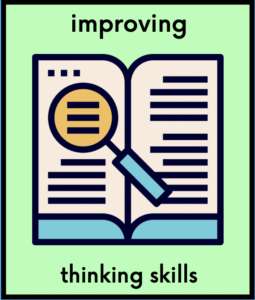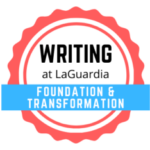
For ENA 101 Faculty in the small-group classroom: Script for the intro to critical reading video
English 101 requires students to write a research paper. Good reading skills are a central element in solid writing, especially when research is involved. This ALP class strengthens critical reading skills and improves writing allowing for more time on task and full explication. There are different ways of reading. If we are reading for fun, we probably won’t read critically, nor should we. But afterwards, when we decide we liked or didn’t like it and explain this to someone else why, we begin making judgments and reading critically.
And, in order to write a research paper or critical essay, short or long in any major, one must be able to read (both closely and by skimming), analyze, and engage with the readings, and use them as evidence for our points. Critical inquiry means moving beyond the surface or literal meanings of different kinds of texts and inferring both what the writer is saying and how that can affect the paper’s argument. These are different things. one may have to assess the quality and reasoning of the reading or source. This process of judging is called critical thinking generally and critical reading in particular. One of the fundamental goals of a college education is to become this kind of critical reader and critical thinker and be able to express those thoughts in clear writing of academic quality. Critical readers:
- don’t read looking only for information or data
- do read looking for ways of thinking about the subject matter
To critically engage a text one asks questions of it. We want to help one to develop these critical abilities and in this section of the class we will discuss rhetorical topics. Some questions a critical reader asks might include:
- What are the basic facts (context) surrounding the reading such as: The author, title, year of publication and venue/place of publication? Social media/facebook or a vetted publication? These details matter to critical readers
- Who/where is the audience? How does it affect the writer’s expression of ideas?
- What is the piece’s genre? That is, is it fiction or journalism, drama, poetry, a research article? Is it structured as a narrative, exposition or explanation, or an argument for or against a debatable point? If there is a narrator, what is that character’s relation to the author?
- Once we are looking at the content one should ask:
a. What is the general topic of this reading?
b. What is the thesis?
c. Where is the support, evidence, or development of that thesis (if it is an argument or explanation)?
d. What is the purpose (what does the author want one to know or to think about in a new and different way)? Where are they going with it?
e. What kinds of literary techniques, language, tone or style is used to get this across? Does it evoke any particular response?
- What/where is the most significant information or argument (main idea) in the passage?
- How do one assess the writing’s overall quality as evidence for our own papers?
- How do one then use the information effectively in our paper, if we are writing one? (E.g., critically selecting the data and quotations relevant to our own thesis)
In this ENA class section, one will investigate these topics more fully. We have chosen readings that are related to the class themes as well as some that are not directly related.
To explain what we mean, here is a short essay on experimental cancer research that was published in the New York Times by a student winner of a science writing contest. One way to engage with the world of a text in college is to annotate it as one read. That is, we take notes in the margins regarding striking or important points. We llook at the first paragraph so that students can see what is meant. This can be a light or detailed process, but will be very helpful when you need to return to study and write about it. It is a way to help you remember key details and to make the reading experience our own.
A New Cancer Treatment That Is Faster, More Efficient and Less Risky Is Coming: Bacteria Bombs [eb1]
William Chesney, NYTimes, May 7, 2020[1]
Bacteria are usually thought of as microscopic, disease-causing nuisances[eb2] . They have long been seen as something that needs to be washed away with soap and warm water, or killed en masse with hand sanitizer. But what if these stigmatized organisms could be used to fight cancer, the stubborn killer devastating millions of people? Scientists at the University of California, led by Jeff Hasty, are working to genetically engineer bacteria that will infiltrate tumors and kill them. Combined with conventional treatment such as chemotherapy, researchers are hoping bacteria will be very effective at killing tumors and, further, stopping them from spreading. If proven safe and effective, this bacterial treatment could provide a vital victory in the war against cancer[eb3].
The immune system regularly patrols the body to find and destroy cancerous cells, but tumors can disguise themselves as normal cells by releasing a protein that tells the body to leave the tumor alone. And so, the tumor hides in plain sight, invading the healthy tissue around it. Tumors use blood vessels that branch all over the surface of the tumor to steal resources. Chemotherapy delivers cancer-killing drugs to the bloodstream, but these drugs can only reach as far as the blood vessels reach, and most of the tumor’s blood vessels do not get to the center of the tumor[eb4].
This is where the bacteria, specifically salmonella, can come to the rescue.[eb5] The scientists at the University of California have changed the DNA of bacteria to seek out these tumors, and populate them without invading the rest of the body. The bacteria settle in and start to replicate. But, like little bombs, they soon explode and release “a toxic cocktail” in the words of Dr. Sally Adee. The cocktail contains “three types of cancer-killing drugs: one that destroys cell walls, one that alerts the body’s immune system, and one that triggers cells to die” according to Dr. Adee. This allows the bacteria to attack the tumor directly in a localized way to keep the damage away from other healthy cells. Importantly, it also alerts the immune system to begin its offensive by destroying the tumor’s immunosuppressive proteins[eb6]. In his Nature Reviews Cancer article, “Engineering the Perfect (Bacterial) Cancer Therapy,” the University of Massachusetts professor Neil Forbes said, “the immune system plays a complicated role in bacteriolytic therapy; it provides a mechanism to guide bacterial accumulation, but also impedes dispersion and efficacy.” Thus the body and these bacteria form a surprising team in their war against cancer.
Of course, this treatment has risks. The main danger is that the bacteria will become the enemy and infect the person. To prevent this, researchers have modified the bacteria to not only thrive in the environment of a tumor, but also to struggle to survive in healthy tissue. This is a revolution in the way people have thought about cancer treatment. Bacteria may soon join the list of unlikely allies in the fight against cancer, joining the ranks of debilitating chemicals and harmful radiation.
Works Cited
Adee, Sally. “Self-Destructing Bacteria Are Engineered to Kill Cancer Cells.” New Scientist, 20 July 2016.
Forbes, Neil S. “Engineering the Perfect (Bacterial) Cancer Therapy.” Nature Reviews Cancer, 14 Oct. 2010.
Williams, Thomas. “New Cancer Treatment? Scientists Have Programmed Bacteria to Kill Cancer Cells in Mice.” The Conversation, 21 July 2016.
Zimmer, Carl. “New Weapons Against Cancer: Millions of Bacteria Programmed to Kill.” The New York Times, 3 July 2019.
[1] William Chesney, NYTimes, May 7, 2020, Learning Network
William Chesney was one of the top eight winners of the Learning Network’s first-ever STEM Writing Contest, from 1,618 entries.
[eb1]Title indicates the topic and refers to the point
[eb2]The first sentence may be a “hook”
[eb3] This is the thesis statement, and also the central topic and focus of the passage
[eb4]This paragraph describes the problem to which the bacteria is the solution and includes important data
[eb5]Topic sentence of this paragraph
[eb6] Key information for oner synthesis of the main idea of the article




Leave a Reply